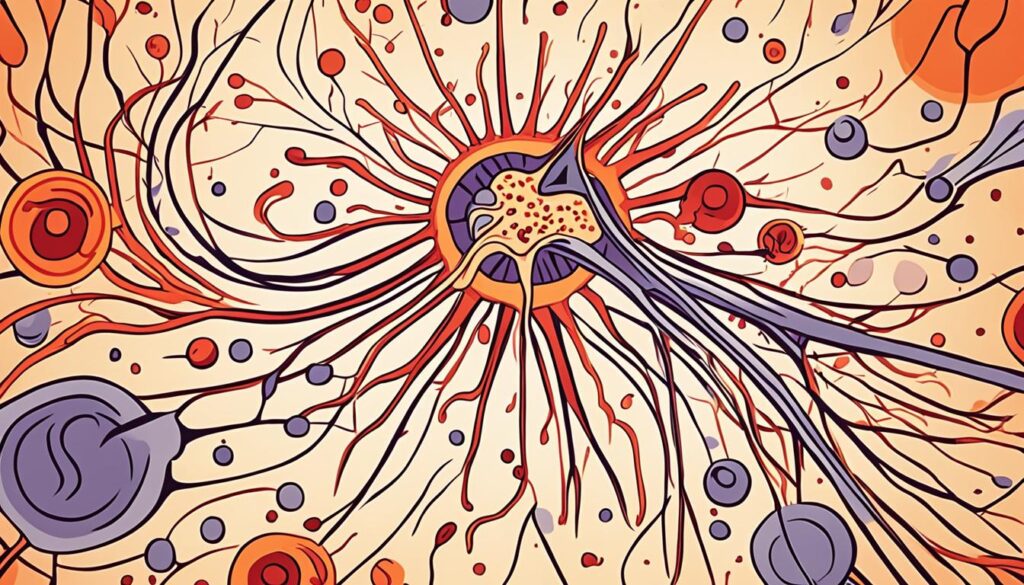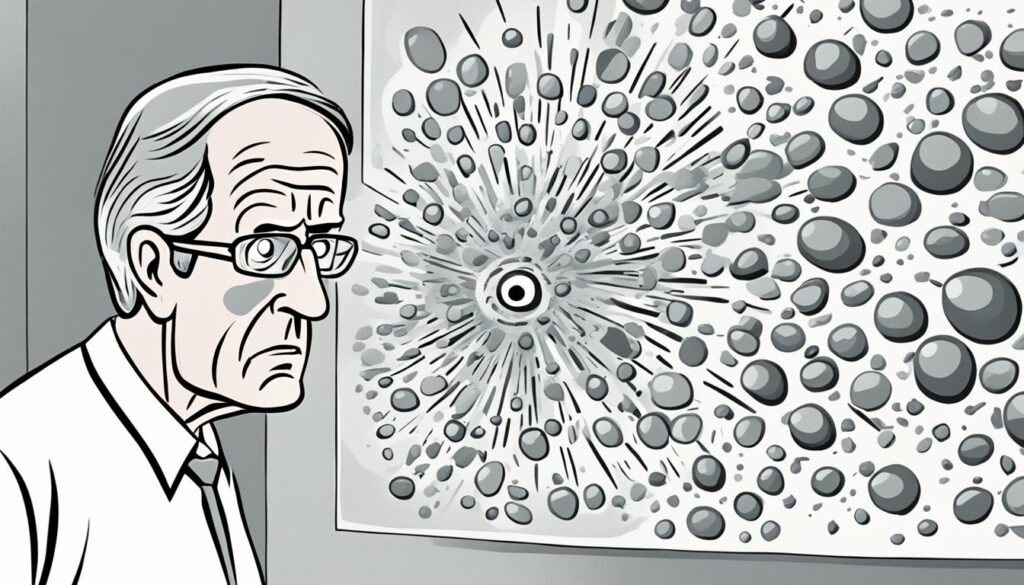If you’ve been diagnosed with giant cell arteritis (GCA), it’s normal to feel worried. This type of vasculitis leads to blood vessel inflammation. Serious issues can happen if not treated. But, with quick and right treatment, you can handle the symptoms and lower risks, like losing your vision.
With GCA, blood vessels in the scalp and head are often affected. These include the temples’ arteries, leading to its other name, “temporal arteritis.” It might also connect with another condition called polymyalgia rheumatica (PMR). About half of GCA patients also have PMR symptoms. The usual sign is a persistent headache, mainly at the temples, yet it can hurt anywhere on the head.
Feeling tired, not hungry, losing weight, and jaw pain when eating are common too. If the eye’s blood supply gets inflamed, your sight might get worse, or you could lose it suddenly. Starting GCA treatment right away is vital to avoid this serious issue.
The main GCA treatment is high-dose corticosteroid therapy. It often begins with 40-60 mg of prednisone daily. This big start dose aims to swiftly decrease blood vessel inflammation and ease symptoms. The dose is then slowly reduced, ideally to 5-10 mg per day in a few months. Many need to take corticosteroids for one to two years before stopping.
Also, the biologic drug tocilizumab is now an option for GCA treatment. It can cut the need for long-term corticosteroids by fighting the condition’s cause.
Treating GCA can be complex. But, with your healthcare team’s help and active role in managing your health, you can protect yourself. Look for more information on quick treatment’s importance, handling side effects, and possible treatments for giant cell arteritis. Stay informed.
Table of Contents
ToggleUnderstanding Giant Cell Arteritis
Giant cell arteritis (GCA), or temporal arteritis, is a kind of vasculitis. It causes blood vessels to get inflamed. The arteries mainly affected are in the head, especially near the temples. This is why it’s sometimes called “temporal arteritis.” What’s interesting is it may come with a condition called polymyalgia rheumatica (PMR). About half of all GCA patients have symptoms of PMR as well.
What is Giant Cell Arteritis?
Giant cell arteritis affects people over 50, being more common in women. It also shows up more in white folks, especially from Northern Europe or Scandinavia. We’re not completely sure what causes it. But, experts think it happens when the body’s immune system mistakenly attacks artery walls. This wrong attack might come from both our genes and things in our environment.
Symptoms of Giant Cell Arteritis
A big sign of GCA is a new, steady headache. This often happens near the temples but can show up elsewhere too. Feeling tired, losing your appetite, dropping weight, and aching like you have the flu are other common signs. Jaw pain while eating is also a key symptom. If the inflammation affects the eye-bathing blood vessels, it can cause sudden blindness. This is an emergency and needs quick treatment.
Causes and Risk Factors
We don’t completely know what causes giant cell arteritis. But, we think it’s tied to the immune system causing artery wall inflammation. Certain genes and the environment might make some people more likely to get GCA. It shows up more in older folks, mainly women, and those of white, European descent.

The Importance of Prompt Treatment
Getting treatment quickly for giant cell arteritis (GCA) is really important. It helps avoid big problems, like losing your sight. GCA can make you lose your vision suddenly and forever in one or both eyes. The problem is, the swelling in your blood vessels can stop blood from getting to your eyes. This keeps your eyes from getting the oxygen and food they need. The consequences of delayed treatment giant cell arteritis are very serious.
Vision Loss and Other Complications
Besides vision loss giant cell arteritis, GCA can cause other major issues. For example, it can make a blood vessel in the aorta weak. When this happens, it might swell and burst, which could be deadly. GCA can also rarely lead to a stroke. So, it’s really important to treat GCA right away. Doctors usually use strong steroids to stop the swelling and prevent any lasting harm.

Giant cell arteritis treatment
The main medicine for giant cell arteritis (GCA) is high-dose corticosteroid therapy.
Doctors often start with prednisone 40 to 60 mg daily to help with symptoms and prevent eye problems. If symptoms don’t improve, the prednisone can go up to 80 mg daily.
Corticosteroid Therapy
This high dose of corticosteroids reduces blood vessel inflammation. It eases headaches and vision issues quickly. Over a month, the dose lowers. The aim is to get down to 5-10 mg daily.
Dosage and Duration
Most patients take corticosteroids for one to two years. It takes a long time to fully stop. Starting with smaller doses (less than 40 mg daily) isn’t a good idea to treat new GCA cases.
Monitoring and Adjusting Treatment
Patients get checked often during treatment. Doctors watch for less inflammation and better symptoms. And they look out for steroid side effects. The plan changes if needed, based on how the patient is doing.

Managing Side Effects
Corticosteroid therapy is good for giant cell arteritis (GCA), but it has side effects. These can happen because high doses and long use are common.
Side effects include bone loss, more chance of getting osteoporosis and fractures. Also, you might gain weight, not sleep well, or feel bad. Some people have muscle weakness, get cataracts, and bruise easily. Doctors might add more meds or suggest changes in diet and exercise to help.
Preventing and Treating Side Effects
Doctors keep a close watch on patients. They do this with regular tests, like bone density scans. Most side effects are not forever and can be fixed with the right help.
Talking openly with your healthcare team is important. They can help catch and treat any new side effects. This makes the treatment for giant cell arteritis better.
Additional Treatment Options
While corticosteroids are key in treating giant cell arteritis (GCA), sometimes more steps are needed. Tocilizumab (Actemra) is one such step. It was FDA approved in 2017 for GCA treatment. This medicine reduces how much corticosteroids you might need by working on a part of your body’s immune system.
Biologic Medications
Tocilizumab offers a new way to help GCA patients. Some people can’t handle the side effects of long-term corticosteroids. Or their GCA might keep coming back. Tocilizumab lets you use less corticosteroids, while still managing the disease well.
Methotrexate and Other Immunosuppressants
Other medicines, like methotrexate, are also looking promising for GCA. They might help if your GCA keeps getting worse, or if you need less corticosteroids. Right now, doctors are working to find the best mix of these medicines. They want to help people with GCA better, without as many side effects from too many corticosteroids.
Conclusion
Giant cell arteritis (GCA) is a serious problem. It needs fast treatment to stop major issues, like sudden vision loss. The usual treatment is high doses of corticosteroids. You might start with 40-60 mg of prednisone each day and lower it slowly over one to two years. But, these medicines can cause many side effects. So, your doctor will watch you closely.
Doctors are also looking into new ways to treat GCA. They are trying medicines like tocilizumab and methotrexate. These might help lower the time you need to take corticosteroids. But the main thing is to work together with your healthcare team. This is key to handling GCA well and getting the best results.
Learning the symptoms and causes of GCA is important. Quick treatment can prevent big problems. By teaming up with your doctor and checking out all treatment choices, you can play a big part in your health. This can be good for your well-being overall.
FAQ
What is giant cell arteritis?
Giant cell arteritis (GCA) is a disease that causes blood vessel inflammation. It mainly affects the arteries in the head and scalp. This includes those over the temples. It’s also called “temporal arteritis.” GCA often occurs with another condition called polymyalgia rheumatica (PMR).
What are the symptoms of giant cell arteritis?
The main sign of GCA is a new kind of headache, often near the temples. You might also feel tired or notice you’re eating less. Weight loss can happen too. Pain in the jaw when you chew is common. If GCA affects the eyes, it can cause vision problems and even sudden vision loss.
What are the causes and risk factors of giant cell arteritis?
Doctors are still learning what causes GCA. They believe the immune system attacks artery walls wrongly. This condition is more likely to affect people over 50, especially women. White people tend to get it more. Certain genes and the environment might play a part.
Why is prompt treatment of giant cell arteritis crucial?
Getting treatment quickly is very important with GCA. It helps prevent serious problems like losing your sight. GCA can slow the blood flow to your eyes. This leads to a sudden loss of vision. It can also cause aortic aneurysm and stroke.
What is the primary treatment for giant cell arteritis?
The main treatment is to take corticosteroids by mouth. Doctors usually start with 40-60 mg of a drug like prednisone every day. This strong dose helps to lower the vessel inflammation fast. Then, over several months, the amount of medicine you take is slowly reduced.
What are the potential side effects of corticosteroid therapy for giant cell arteritis?
Taking corticosteroids can cause side effects such as bone and muscle problems. You might notice you’re gaining weight. Sleep, mood, and skin problems are possible too. Doctors keep a close eye on you to make sure these issues are managed.
Are there any other treatments for giant cell arteritis besides corticosteroids?
Yes, though corticosteroids are the main treatment, other drugs might be used. For example, tocilizumab can help. Methotrexate is another option. These can be used if your disease doesn’t get better or comes back after corticosteroids.
Source Links
- https://www.ncbi.nlm.nih.gov/pmc/articles/PMC3014829/
- https://rheumatology.org/patients/giant-cell-arteritis
- https://emedicine.medscape.com/article/332483-treatment
- https://www.mayoclinic.org/diseases-conditions/giant-cell-arteritis/symptoms-causes/syc-20372758
- https://www.mayoclinic.org/diseases-conditions/giant-cell-arteritis/diagnosis-treatment/drc-20372764
- https://www.uptodate.com/contents/treatment-of-giant-cell-arteritis
- https://www.ncbi.nlm.nih.gov/pmc/articles/PMC4468893/
About The Author

This article is medically reviewed by Dr. Chandril Chugh, Board-Certified Neurologist, providing expert insights and reliable health information.
Dr. Chandril Chugh is a U.S.-trained neurologist with over a decade of experience. Known for his compassionate care, he specializes in treating neurological conditions such as migraines, epilepsy, and Parkinson’s disease. Dr. Chugh is highly regarded for his patient-centered approach and dedication to providing personalized care.
→ Book a consultation to discover which remedies suit your needs best.




